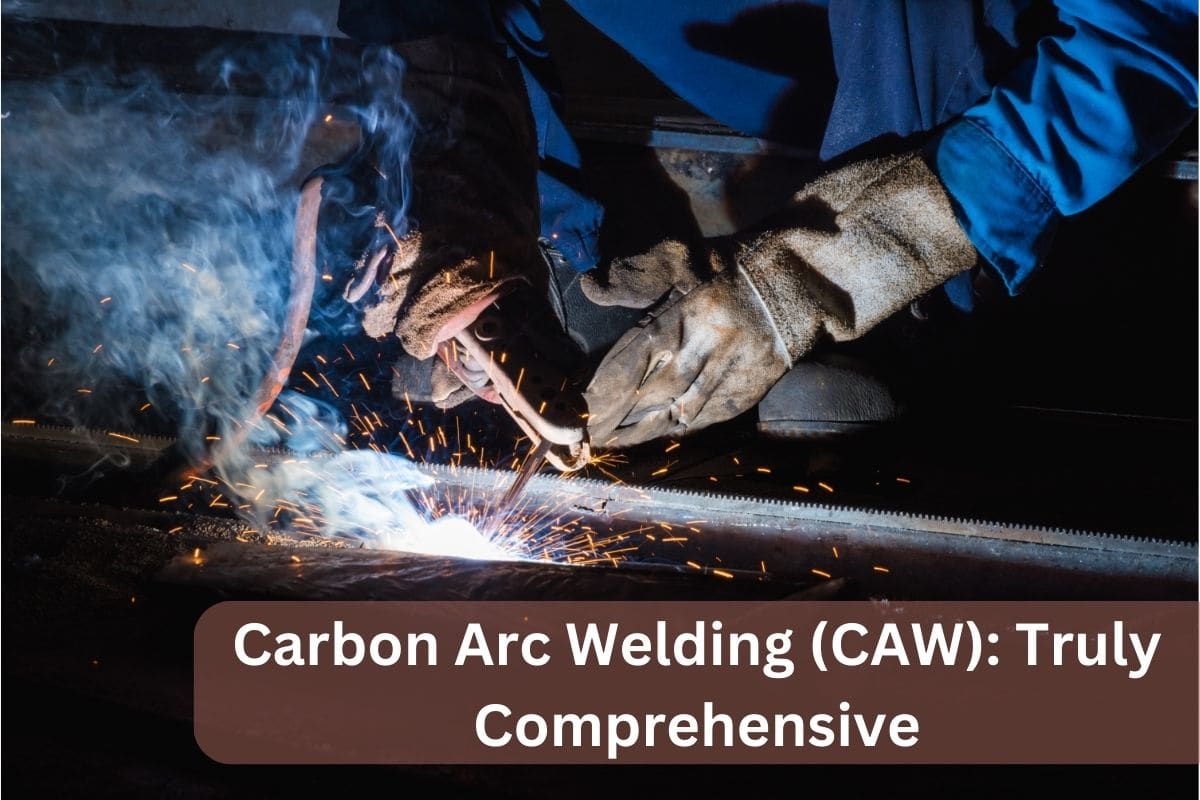If you’re interested in welding, you’ve probably heard of popular techniques like MIG welding or Flux Core welding. But have you ever come across carbon arc welding?
This welding method has a rich history and offers some unique advantages.
In today’s post, we’ll delve into everything you need to know about carbon arc welding, from its origins to its modern-day applications.
A Walk Through History
Carbon Arc Welding (CAW) isn’t just any welding process; it’s the pioneer, the one that started it all.
The fundamental principle it uses, the electric arc, was discovered by Sir Humphry Davy back in 1800. It wasn’t until 1881 that Nikolay Benardos and Stanisław Olszewski took Davy’s electric arc and turned it into CAW, patenting it under the name “Elektrogefest.”
In a way, every arc welding technique you see today, whether it’s MIG welding or Flux Core welding, owes a little something to CAW.
What Exactly is Carbon Arc Welding?
This method employs a non-consumable carbon electrode to generate an electric arc, thereby creating intense heat. We’re talking temperatures upwards of 3,000 ºC or even 6,500 ºF!
This extreme heat melts the metals you’re working on, allowing them to fuse together as they cool and solidify.
Think of it like supercharged glue for metals, only this glue is made out of the same molten metal you’re joining.
Choosing Your Carbon Electrode
Here’s a pivotal decision you’ll make: baked carbon or graphite electrode?
Baked carbon offers durability, which is excellent for prolonged use. But, like many robust things in life, it sacrifices a bit of finesse; the arc isn’t as stable.
On the flip side, graphite electrodes produce a much smoother arc, giving you greater control. However, this comes at the cost of faster wear and tear.
So, your choice would depend on whether you value longevity or finesse in your welding work.
Read Also : Stick Welding from A to Z: The Comprehensive Guide
Equipment Details
While the technique may be ancient, the equipment for carbon arc welding has come a long way.
- Electrode: The diameter of the carbon electrode can vary, but typically, you’ll find them ranging from 3 to 22 mm.
- Power Source: Carbon arc welding relies exclusively on direct current (DC) machines. These can be rotating or rectifier types. It’s essential to use Direct Current Electrode Negative (DCEN) to ensure that electrons concentrate the welding temperature onto your workpiece.
- Personal Protective Equipment: Safety comes first, especially in welding. You’ll need a set of specialized gear, including welding helmets, gloves, goggles, jackets, and boots. Why do welders wear masks and goggles? Because safety is paramount when you’re dealing with extremely high temperatures and bright arcs.
Variations to Know About
Carbon arc welding has some interesting variations that adapt its basic principle to specific needs. These are:
- Twin Carbon Arc Welding (TCAW): Uses two carbon electrodes instead of one. This variation essentially doubles up on the arc creation mechanism.
- Gas Carbon Arc Welding (CAW-G): Although it has lost its commercial appeal, it’s worth mentioning as part of the carbon arc welding family.
- Modern Alternatives: Techniques like tungsten-arc welding, plasma-arc welding, and atomic-hydrogen welding have largely replaced CAW. Each comes with its own set of advantages:
- Tungsten-Arc Welding (GTAW or TIG): Uses a tungsten electrode.
- Plasma-Arc Welding (PAW): Known for precision.
- Atomic-Hydrogen Welding (AHAW): Excels in preventing contamination.
All these variations, including carbon arc welding itself, often employ non-consumable electrodes. Some even use a filler metal to aid the bond in the workpieces.
Applications and Materials
Here’s a quick look at what you can and can’t do with carbon arc welding in terms of materials:
What You Can Weld
- Ferrous Metals: Like steel, for example. This is often a go-to for many welders using carbon arc welding.
- Non-Ferrous Metals: Such as copper, often used in electrical applications.
- Special Alloys: High-nickel alloys and other specialized materials are also fair game.
- Thin Sheets: Galvanized sheets and thinner gauges of stainless steel can be welded effectively.
What You Should Avoid
- Carbon-Sensitive Metals: Any metal that might react poorly to carbon particles is a no-go for carbon arc welding.
This technique is versatile but not all-encompassing, so it’s essential to pick the right material for your specific job.
Pros and Cons of Carbon Arc Welding
The Bright Side
- Cost Savings: Carbon arc welding requires less expensive equipment than many other welding types.
- Ease of Use: You don’t need to be a master welder to get good results.
- Minimal Distortion: CAW doesn’t warp your workpiece much, which is a big plus.
- Speed and Efficiency: If you’re working on a large-scale project, the high deposition rates and faster weld speeds can be a godsend.
On the Flip Side
- Quality Issues: While easy, carbon arc welding can sometimes produce less-than-perfect welds.
- Contamination Risks: The carbon electrode could introduce unwanted carbides into your workpiece.
- Porosity Risks: Without shielding gas, you risk introducing porosity into your welds.
Read Also : Submerged Arc Welding (SAW): A Comprehensive Overview
Conclusion
Carbon arc welding remains a unique and viable option for specific welding needs.
While it may not be as popular as it once was, it offers a blend of cost-efficiency, ease of use, and a broad application range that keeps it relevant even today.
So the next time you find yourself in need of a welding solution, consider this time-tested method. It just might be the perfect fit for your project!


